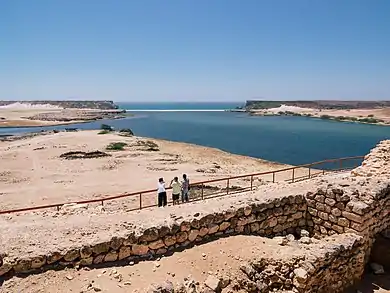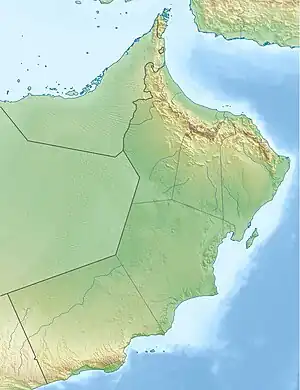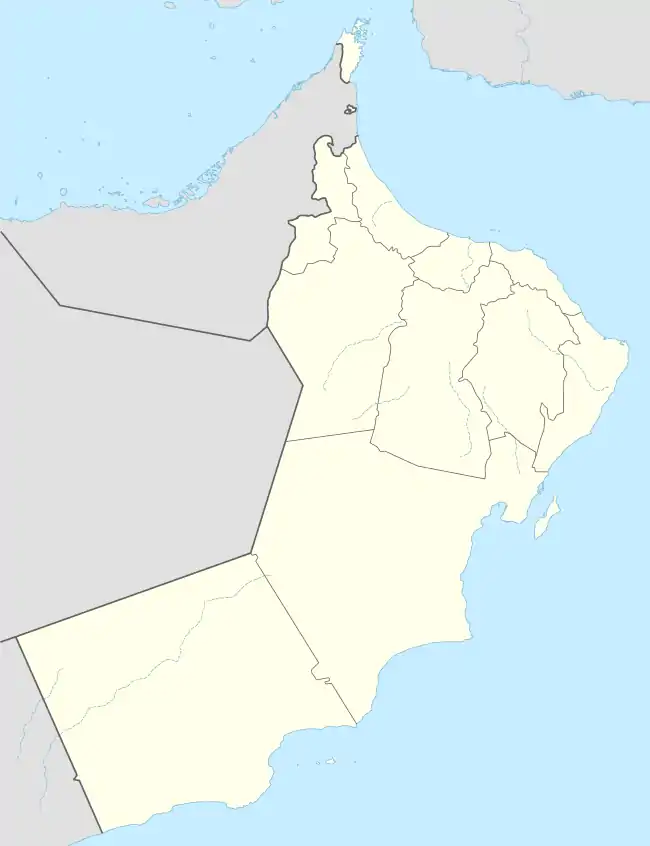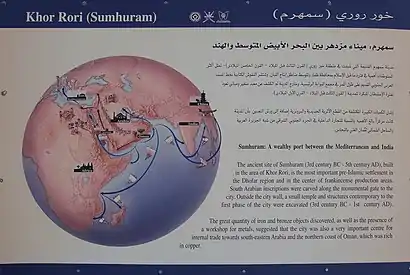Khor Rori
Khor Rori (Arabic: خور روري, romanized: Khawr Rawrī) is a bar-built estuary (or river mouth lagoon) at the mouth of Wādī Darbāt in the Dhofar Governorate, Oman, near Taqah.[1] It is a major breeding ground for birds,[2] and used to act as an important harbour for frankincense trade when it was an open estuary.[1] Khor Rori has been identified as the location of Moscha Limen (Ancient Greek: Μόσχα λιμήν, probably meaning "the harbour of young shoots (μόσχος)" and referring to the possible mangrove vegetation in the past)[3] and Abyssapolis (named after the abyss besides the waterfall of Wādī Darbāt) in ancient Greek literature.[4][5][6] The area represents a popular tourist spot within Oman and since 2000, is a part of the UNESCO World Heritage Site, the Land of Frankincense.[7]
| Khawr Rawrī | |
|---|---|
| Khor Rori | |
 View of Khor Rori from the ruins of Sumhuram, with Inqitat Mirbat on the left and Inqitat Taqah on the right | |
 Khawr Rawrī | |
| Location | Wilayat Taqah, Dhofar Governorate, Oman |
| Coordinates | 17°02′21.62″N 54°25′49.72″E |
| Type | bar-built estuary (river mouth lagoon) |
| Native name | خور روري (Arabic) |
| River sources | Wādī Darbāt |
| Ocean/sea sources | Arabian Sea |
| Max. length | 2.5 kilometres (1.6 mi) |
| Max. width | 0.4 kilometres (0.25 mi) |
| Max. depth | 5 metres (16 ft) |
| References | [1] |
سمهرم | |
 The ruins of Sumhuram | |
 Shown within Oman | |
| Alternative name | Samharam, Samhuram, Sumharam |
|---|---|
| Location | Wilayat Taqah, Dhofar Governorate, Oman |
| Coordinates | 17°2′20.4″N 54°26′4″E |
| Type | fortified port city |
| Part of | Land of Frankincense |
| History | |
| Founded | 3rd century BC |
| Abandoned | 5th century AD |
| Cultures | Kingdom of Ḥaḍramawt |
Khor Rori is best known for the ruins of the ancient fortified port city of Sumhuram on the eastern bank, which was founded in the 3rd century BC as an outpost for the kingdom of Ḥaḍramawt.[8] After the eclipse of Ḥaḍramawt, Sumhuram was under the influence of the Kingdom of Ḥimyar, as indicated by the Himyarite coins excavated from there.[9] It was finally abandoned in the 5th century, most likely due to the formation of the sandbar blocking the estuary.[1][10]
There are also archaeological ruins on the two promontories at the mouth of Khor Rori. The eastern promontory (Inqitat Mirbat[11]) is better explored than the western promontory (Inqitat Taqah[11]).[12] Inqitat Mirbat, also known as Khatiya or al-Ḥamr al-Sharqiya,[4][13] had been inhabited by the 4th century BC before the emergence of Sumhuram, and its settlement history might date back to the 8th century BC.[14] It was abandoned in the 1st or 2nd century,[14] and re-occupied in the medieval period.[13]
History
Inscriptions at Khor Rori report that the town of Sumhuram (Hadramautic: s1mhrm), was founded on royal initiative and settled by Hadhrami emigrants. The Dhofar region was the main source of frankincense in the ancient period, and it seems likely that the foundation of the settlement by the Hadhramaut was in part motivated by wish to control the production of this valuable commodity. Most scholars identify Khor Rori with the frankincense exporting port of Moscha Limen mentioned in this region in the first century CE merchants guide, the Periplus of the Erythraean Sea.
The discovery of Khor Rori / Sumhuram is credited to the English explorer James Theodore Bent, with his wife Mabel, who identified the site during their travels in the region in January 1895.[6] The site has been excavated by the American Foundation for the Study of Man (AFSM) in the early 1950s and by the Italian Mission to Oman (IMTO) since 1994. The excavations have uncovered the ground plan of the settlement and has attested maritime contacts with the Ḥaḑramite homeland, India and the Mediterranean. It was inscribed in 2000, along with other sites along the Incense Route in Oman, as part of the World Heritage Site "Land of Frankincense".
In 1908, J.G. Lorimer recorded Khor Rori in his Gazetteer of the Persian Gulf, noting its location as the eastern extremity of Dhofar proper. He wrote:
A remarkable lake or inlet of the sea running a mile or more inland ; it is the estuary of Wadi Dirbat from Jabal Samhan.
The inlet is divided from the sea by a sand bar over which the water flows at high tide. A peninsula, once fortified, adjoins the east side of the entrance. Remains of ancient buildings surround the lake. There is a fortified rock at the entrance to the inlet, which is called Khatiyah. This harbour is the ancient Moscha, or Abyssapolis.[15]
Other contexts
In tourism literature, Sumhuram is occasionally promoted as the summer palace of the Queen of Sheba,[16] the legendary ruler of the Sabaʾ Kingdom living in the 10th century BC.[17] It contradicts archaeological evidence which shows that Sumhuram was founded in the 3rd century BC by the kingdom of Ḥaḍramawt.[8]
Some members of The Church of Jesus Christ of Latter Day Saints believe that Khor Rori is the "land Bountiful" where Nephi from the Book of Mormon stayed during his travels from Jerusalem (First Nephi, chapter 17).[18]
Gallery
 Greater flamingos in Khor Rori
Greater flamingos in Khor Rori Information board of Sumhuram
Information board of Sumhuram Information board of Sumhuram
Information board of Sumhuram The ruins of Sumhuram
The ruins of Sumhuram Frankincense tree in the ruins of Sumhuram
Frankincense tree in the ruins of Sumhuram
References
- Hoorn, Carina; Cremaschi, Mauro (2004-10-07). "Late Holocene palaeoenvironmental history of Khawr Rawri and Khawr Al Balid (Dhofar, Sultanate of Oman)". Palaeogeography, Palaeoclimatology, Palaeoecology. 213 (1): 1–36. doi:10.1016/j.palaeo.2004.03.014. ISSN 0031-0182.
- "Dhofar beckons lovers of nature tourism". Ministry of Tourism (Oman). 29 June 2011. Retrieved 26 November 2019.
- Bukharin, Mikhail (2002). "The Name of Moscha Limen". In Avanzini, Alessandra (ed.). Khor Rori Report 1. Pisa, Italy: Edizioni Plus. pp. 323–324. ISBN 88-8492-031-0.
- Bent, James Theodore (1895). "Exploration of the Frankincense Country, Southern Arabia". The Geographical Journal. 6 (2): 109–133. doi:10.2307/1773739. ISSN 0016-7398. JSTOR 1773739.
- Bent, James Theodore (1895). "The Land of Frankincense and Myrrh". The Nineteenth Century. 38 (224): 595–613.
- Bent, James Theodore; Bent, Mabel Virginia Anna (1900). "The Identification of Abyssapolis". Southern Arabia. London, England: Smith, Elder & Co. pp. 268–276.
- "Land of Frankincense". UNESCO World Heritage Centre. 2000. Retrieved 2021-03-25.
- Avanzini, Alessandra; Sedov, Alexander V. (2005). "The stratigraphy of Sumhuram: new evidence". Proceedings of the Seminar for Arabian Studies. 35: 11–17. ISSN 0308-8421. JSTOR 41219365.
- Sedov, Alexander V. (2008). "The Coins from Sumhuram: the 2001A-2004A Seasons". In Avanzini, Alessandra (ed.). A Port in Arabia Between Rome and the Indian Ocean, 3rd C.BC-5th C.AD: Khor Rori Report 2. Rome, Italy: L'Erma di Bretschneider. pp. 277–316. ISBN 978-88-8265-469-6.
- Avanzini, Alessandra (2008). A Port in Arabia Between Rome and the Indian Ocean, 3rd C.BC-5th C.AD: Khor Rori Report 2. Rome, Italy: L'Erma di Bretschneider. ISBN 978-88-8265-469-6.
- Avanzini, Alessandra; Orazi, Roberto (2001). "The construction phases of Khor Rori's monumental gate". Arabian Archaeology and Epigraphy. 12 (2): 249–259. doi:10.1034/j.1600-0471.2001.d01-9.x. ISSN 1600-0471.
- Zarins, Juris (2009). Avanzini, Allesandra (ed.). "The Latest on the Archaeology of Southern Oman". Journal of the American Oriental Society. 129 (4): 665–674. ISSN 0003-0279. JSTOR 25766909.
- Rougeulle, Axelle (2008). "A Medieval Trade Entrepôt at Khor Rori? The Study of the Islamic Ceramic from al-Ḥamr al-Sharqiya". In Avanzini, Alessandra (ed.). A Port in Arabia Between Rome and the Indian Ocean, 3rd C.BC-5th C.AD: Khor Rori Report 2. Rome, Italy: L'Erma di Bretschneider. pp. 645–667. ISBN 978-88-8265-469-6.
- Lischi, Silvia (2021-02-01). "Notes on the South Arabian Occupation of Inqitat". In Hatke, George; Ruzicka, Ronald (eds.). South Arabian Long-Distance Trade in Antiquity: "Out of Arabia". Cambridge Scholars Publishing. pp. 228–244. ISBN 978-1-5275-6533-3.
- "'Gazetteer of Arabia Vol. I' [538] (569/1050)". Qatar Digital Library. Retrieved 26 November 2019. This article incorporates text from this source, which is in the public domain.
- Kessler, Kristel; Raj, Razaq (2018). "Religious Tourism in the Sultanate of Oman: The Potential for Mosque Tourism to Thrive". In Jamal, Ahmad; Griffin, Kevin; Raj, Razaq (eds.). Islamic Tourism: Management of Travel Destinations. Boston, MA: CABI. p. 131. ISBN 978-1-78639-413-2.
- "Queen of Sheba". Encyclopedia Britannica. Retrieved 2021-03-23.
- Potter, George and Wellington, Richard. Lehi's Trail: From the Valley of Lemuel to Nephi's Harbor.http://maxwellinstitute.byu.edu/publications/jbms/?vol=15&num=2&id=415